
- Two invasive blue crab species have recently settled in the Mediterranean.
- Both species are voracious predators that disrupt bottom habitats, shred fishers’ nets and ruin their catches. They’re also edible.
- Mediterranean countries are considering whether to target the invasive crabs to control them, or embrace and even protect them as a new socioeconomic resource for the future.
- This story was produced with the support of the Pulitzer Center.
DJERBA, Tunisia, and SICILY, Italy—On the deck of the Ghanem, which in Arabic means “winner,” sit eight boxes crawling with life. Blue legs and claws teem with each splash of sea water Najib Trabelsi pours over them. Most of the crabs show their spotty greenish-brown carapaces; the upside-down ones stand out in bright white and blue. Trabelsi, 57, and his fishing partner, Fawzi Borji, 53, have been crabbing off the island of Djerba in southern Tunisia since 4:30 a.m. on this mid-May morning. Before heading back to the fishing port of Ajim, the two fishers drop a line of three or four round pots.
When the Ghanem reaches the dock, a broker weighs the catch: 80 kilograms (176 pounds). An average day for Borji and Trabelsi. They will split what remains of 160 Tunisian dinars (about $51) after covering the costs of the fuel for their boat and the sardines they used as bait. Once the broker’s van is full, he’ll drive up to the city of Sfax, where he supplies seafood processing plants.

As a nonprofit journalism organization, we depend on your support to fund more than 170 reporting projects every year on critical global and local issues. Donate any amount today to become a Pulitzer Center Champion and receive exclusive benefits!
“Before the blue crab, we would generally use our nets to catch other kinds of fish,” Borji says. “But since it ruins our nets and cuts them, we have to deal with it by fishing for the blue crab.”
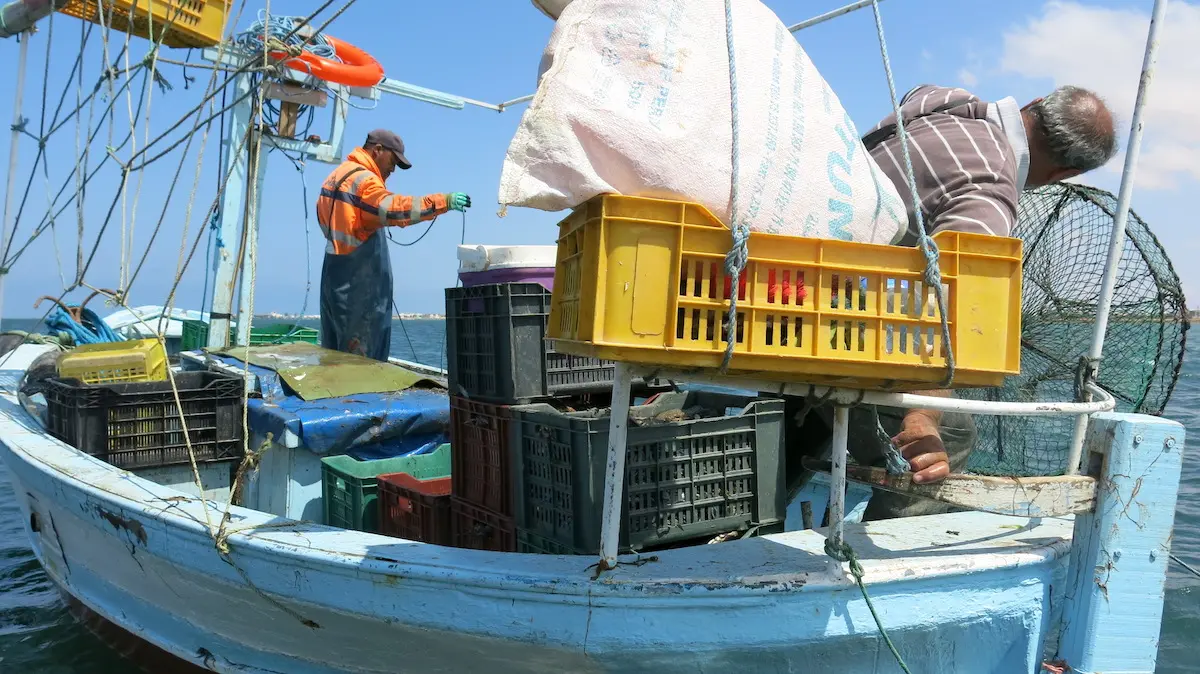
Portunus segnis, the blue swimming crab, made its first official appearance in the town of Ghannouch, 113 kilometers (70 miles) north of Djerba, in 2014. Four years later, it was present in all the country’s gulfs. Native to the western Indian ocean, it first reached Egypt in 1898, 29 years after the opening of the Suez Canal. And though it has spread to at least 10 Mediterranean countries, it has found an ideal habitat in the shallow waters of Tunisia’s Gulf of Gabes. Along this 257-km (160-mi) coastline, which arcs north from Djerba past Ghannouch to Sfax, the blue swimming crab has flourished into an important fishery in a very short time.
It’s among the most interesting, from a commercial point of view, of more than 500 species that have entered the Mediterranean following the removal of the isthmus separating it from the Red Sea, and consequently the Indian Ocean. But it’s not the only blue crab to have recently invaded the Med from afar. A similarly colored species belonging to the same crab family, the Portunidae, but native to the Atlantic coast of the Americas has settled in nearly all Mediterranean countries. In contrast to the blue swimming crab, which thrives in salty waters, the Atlantic blue crab, Callinectes sapidus, prefers brackish lagoons and estuaries. In Tunisia, Egypt, Turkey and other countries, both species coexist, making scientists wonder what the future will hold for them and the biodiversity of the basin. Both crabs are aggressive and voracious predators that target other crustaceans, mollusks and fish. They disrupt the sediment and bottom habitats when they burrow or move about. The sea’s warming waters, mainly due to human-induced climate change, suggest the blue swimming crab might expand its range still further. But there are many uncertainties, and fishing efforts are one of them. Countries are trying to find the right balance between protecting native ecosystems and profiting from this new species, but the line seems thin.
Either way, “the good thing is that we can eat them,” says Guillaume Marchessaux, a postdoctoral research fellow at the University of Palermo in southern Italy.
Marchessaux is working on a cooperative cross-border project between Italy and Tunisia, named Bleu Adapt and supported by the European Union, to exchange perspectives and best practices regarding the two invasive crabs. In Italy and other European countries, fishing initiatives are still scattered and limited to areas like the Ebro Delta in Spain or the Aegean Sea off Greece, where blue crabs have caused headaches for fishers. The initiatives’ main goal has been to keep crab numbers down while supporting fishers in valuing this unusual bycatch. The same spirit guided Tunisia to rapidly create a blue crab fishery in response to the fast and furious initial phase of its invasion. The sector has attracted notable commercial interests, and now the country is considering ways to preserve what has become a precious resource. At the same time, research projects are trying to better understand the ecological impact of these novel species on Mediterranean ecosystems, something that remains little known.
Embracing the invader
In southern Tunisia, P. segnis is “installed and exploited” and “becoming part of the ecosystem of the Gulf of Gabes,” says Olfa ben Abdallah, a specialist in marine biology, population dynamics and stock assessment at the National Institute of Marine Sciences and Technologies (INSTM). Studies are ongoing. Being such an omnivorous and voracious predator, its effect on local resources may be significant, she adds, especially in the Gulf of Gabes, where fish stocks are already under great pressure from overfishing.
In Djerba, some fishers say they first spotted the blue swimming crab even before 2014. “We called it Daesh,” the Arabic acronym for the terrorist group that’s also known as ISIS, says Nabil ben Mimoun, a fisher and treasurer of the local fishers’ association in the town of Guellala on Djerba. “We still call it Daesh because it devours everything, literally!”
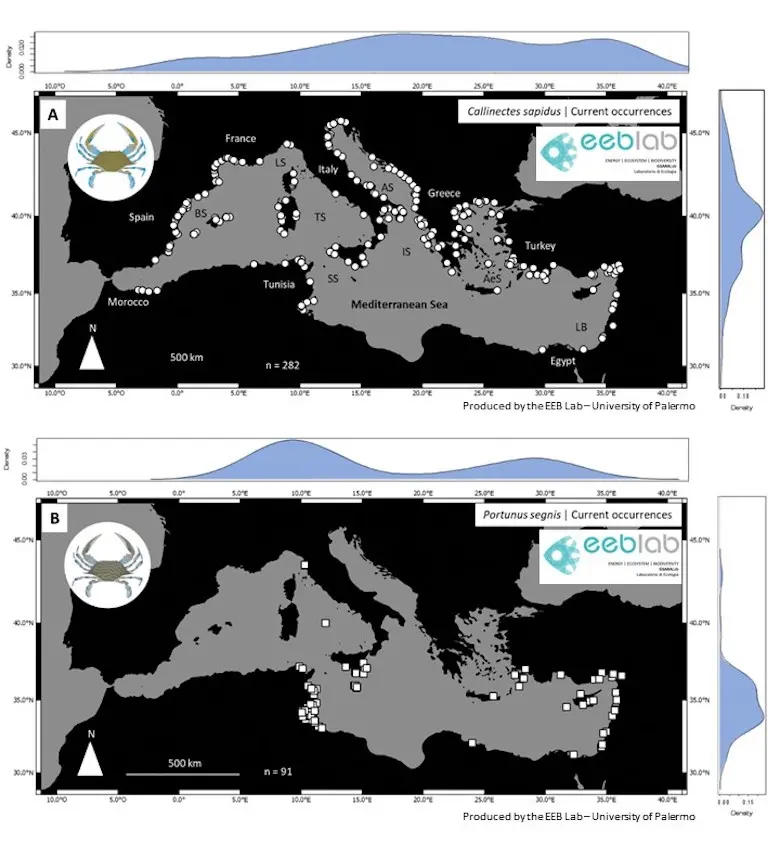
On a gloomy day, Radhia Jouili and her husband, Belgacem Chadi, were returning to Ajim after five hours at sea. They’d caught around 8 kg (17 lbs) of sole and cuttlefish. While Chadi was sailing their 6-meter (20-foot) wooden boat toward the shore, Jouili was busy disentangling blue crabs from the gill net and smashing them. “We must have thrown 50 kilos [110 lbs] of crab, minimum, back into the water,” Chadi told Mongabay.
When it wraps itself in the nets, the crab loses all value. It takes too long to remove them and in the process some parts inevitably get damaged. At the same time, small-scale fishers struggle to fish anything else. With their claws, the crustaceans ruin not just the fishing nets but also the catch. They cut the fish into pieces, so it can’t be sold. “In the past, we replaced our nets every two years,” Jouili says. Now, “we have to change them every four months.”
Fishers’ exasperation and the economic damage are what primarily motivated the Interprofessional Grouping of the Fishery Products (GIPP), a sector organization under the supervision of the Ministry of Agriculture and Water Resources, to intervene to support Gulf of Gabes fishers. With the help of two entrepreneurs from Turkey and South Korea, fishers, fisheries managers and other stakeholders learned to value this new settler. For his efforts on this matter, Fethi Naloufi, a GIPP local representative for Medenine, the governorate that includes Djerba, earned the nickname “Mr. Blue Crab.” In June 2016, GIPP gave 1,300 cages to local fishers and opened collection sites, according to Naloufi, where they could get 1 dinar, or 31 U.S. cents, per kilo of blue crab (about 14 cents per pound). GIPP would sell the crab to factories for a low price. “Our objective was to find a solution for the enormous quantities of crabs,” Naloufi told Mongabay in an email, and to assure the fishermen some money.
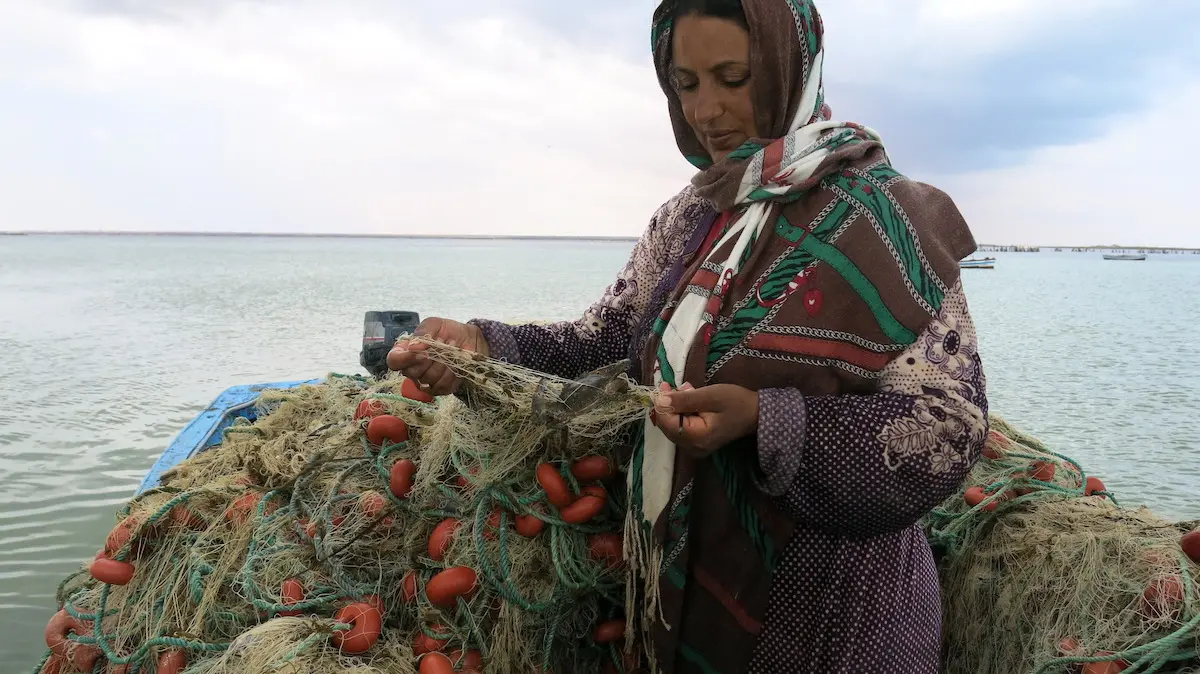
Over the following years, a national plan to direct fishing efforts toward P. segnis and create a market for it was developed and implemented by GIPP and the ministry’s General Directorate of Fisheries and Aquaculture, along with various partners, including the INSTM and the North Africa bureau of the U.N.’s Food and Agriculture Organization. The focus was on identifying the best gear to catch the crab, which turned out to be a multipurpose trap, and on marketing its meat.
At the municipal market in Zarzis, a town 45 km (28 mi) south of Djerba, blue crabs now sell for 5 dinars ($1.59) per kilo, or about 72 cents a pound. Faouzi Kliche, a fishmonger there, says demand is especially high on Fridays by migrants from sub-Saharan countries. Locals weren’t familiar with this crab, he says, but lately local doctors have been sending patients to buy it because of its purported health properties.
Yet the real promise for this new fishery is not represented by the local market. Processing plants, like the one in Sfax where the broker takes Borji and Trabelsi’s catch, sell mostly to foreign clients. Throughout Tunisia, more than 30 processing plants sell blue crab—whole, half, cooked, raw, just the meat, or the claws—to 27 countries, mostly in Asia and Oceania, but also Europe and the U.S. In 2019, landings peaked at more than 14,000 metric tons; of this, more than 3,500 metric tons, worth more than 41 million dinars (about $13 million), were exported. By 2021, landings were down slightly but exports had doubled to 7,561 metric tons worth nearly 76 million dinars (about $24 million), according to Naloufi.
This nascent sector has reached an inflection point. “The stock started to go down really because many fishing efforts target this species,” says Sami Mili, director of the Higher Institute for the Fisheries and Aquaculture of Bizerte, in northern Tunisia. “The stock actually is at the top of its exploitation and if we increase the fishing effort, we will be in a state of overexploitation of this resource,” he adds.
Some fishers and seafood processing company owners say it’s time for the government to regulate the P. segnis fishery to ensure the population continues to flourish. “This is a source of income,” says Ezzedine Mlaouah, one of the major blue crab fishermen in Djerba. “This blue crab must be protected for future generations.”
“Some fishermen return the bearing female crabs to the sea in order to protect them and to ensure the regeneration of the stock,” says ben Abdallah. The government is heeding their call and preparing a law to protect this invader—setting up a fishing season and a legal size for the catch, and banning the removal of egg-bearing females—as if it were a native species.

Keeping the invader at arm’s length
On the opposite side of the Mediterranean, however, controlling, if not eliminating, invasive crab populations remains very much in sight.
The first records of C. sapidus, the other blue crab species, in the Adriatic Sea date back to at least the 1940s. It almost certainly rode from the Atlantic, first to Europe and then to the Mediterranean, in ships’ ballast waters. But its presence remained quite unnoticed until a decade ago.
In 2014, it began showing up in increasing numbers across the brackish lagoons of Lesina and Varano, along the Italian boot’s heel, fouling fishers’ gear and catch there, too. Lucrezia Cilenti, a researcher at the Italian National Council of Research, and her team have been closely monitoring the situation. In addition to promoting blue crab consumption and creating markets, as Tunisia did, since 2016 they have been advocating the intensification of fishing efforts, especially at key moments of the crab’s life cycle. As a single female releases 2 million to 8 million eggs at a time, fishers might target them when they leave the lagoon to disperse the eggs in open waters. Also marketing soft-shell crabs, a delicacy back in the species’ native Chesapeake Bay, could reduce the number reaching sexual maturity. “The goal is to control their numbers,” Cilenti says.
Researchers are currently negotiating fisheries rules in the area with local stakeholders and authorities. In addition, Cilenti’s team is quantifying how many blue crabs the Lesina lagoon can bear without threatening native biodiversity. National and European regulations aim to control invasive species and prevent new arrivals, she adds.
When he started working on Bleu Adapt, Marchessaux visited Lesina to carry out some experiments on the blue crabs there. Then, last year, he found a former salt pan under restoration near the small town of Marausa, in western Sicily, an hour’s drive from his base of Palermo, where C. sapidus has also taken up residence. With a student and fellow researchers, he goes there regularly to study, among other things, how the crab damages the sediment when it burrows in to rest or sleep, or skitters across the surface. He has noticed that in winter months, when the crustacean is dormant and hides in the mud, green crabs, fish and other native species appear all over the shallow seawater ponds once used to make salt. But as soon as the blue crabs reemerge from wintering, other forms of life go missing.
This spring, Marchessaux went to Marausa weekly to fish around 20 crabs for experiments in the ecology laboratory run by Gianluca Sarà at the University of Palermo. In the basement of the Marine and Earth Sciences Department building, he tested C. sapidus’s tolerance to temperatures between 12 and 40° Celsius (53.6 to 104° Fahrenheit), and used the results in models to predict the species’ future distribution under different climate change scenarios. The results don’t suggest expansion beyond the areas where C. sapidus currently is. But those same places will likely offer it welcoming temperatures for longer throughout the year. So it may hibernate for shorter periods and more easily over winter, ultimately leading to more crabs.
Marchessaux plans to apply the same tests to P. segnis. A small population recently settled in the Italian isle of Lampedusa, only 188 km (117 mi) from the Tunisian coast.
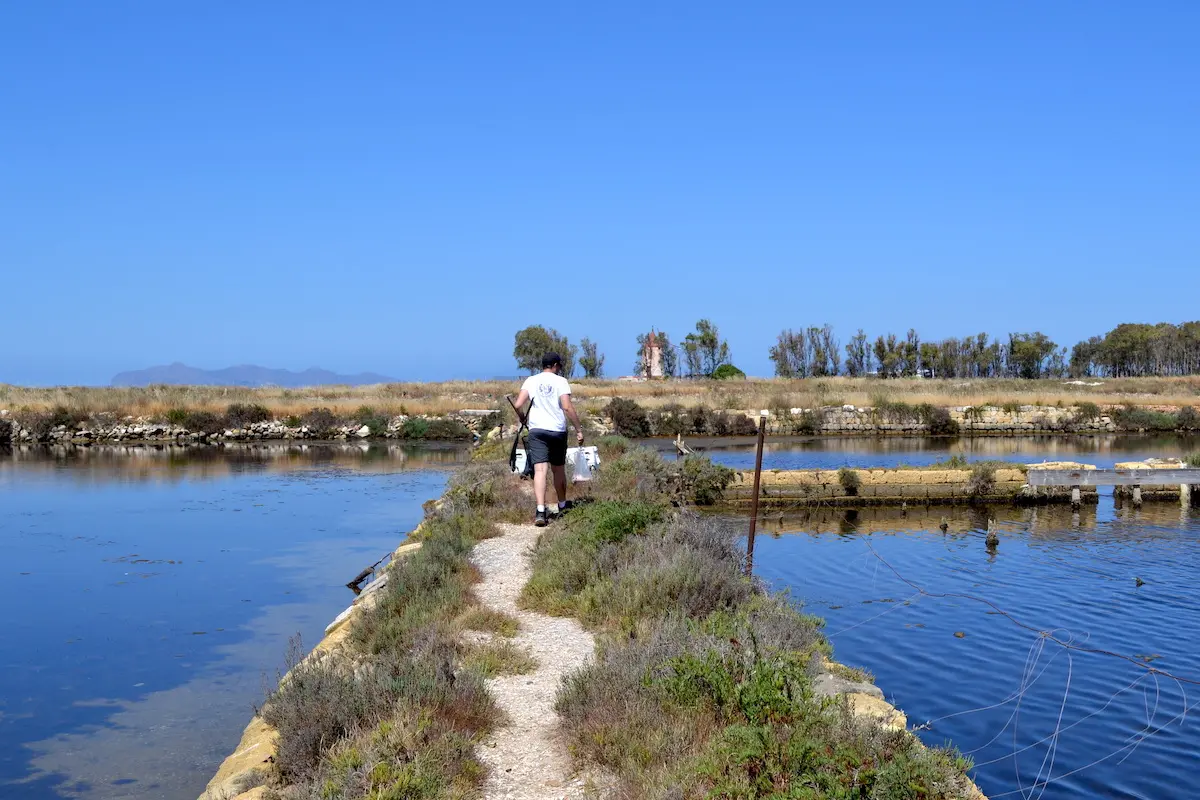
Cross-Mediterranean cooperation
Cross-border projects like Bleu Adapt can help countries learn from each other. In Tunisia, the blue crab has brought new opportunities to coastal areas where many families support themselves with seasonal jobs in fishing and agriculture. Several international development projects are involved in the increasingly structured and valuable blue crab supply chain. Even fishers who are vexed when the crustacean appears in their nets, like Jouili, recognize that the crab has been beneficial. In Ajim, where she lives, about two dozen women work in a blue crab processing plant that recently opened. The job must be quite tiring and can conflict with domestic tasks, but the salary is good, she says.
For their part, Italian fishers are eyeing their neighboring country with interest. Among Bleu Adapt’s partners is the District of Fisheries and Blue Growth, an organization of fisheries stakeholders based in Mazara del Vallo, one of Italy’s major fishing towns, in western Sicily. At the same time, Tunisian researchers might benefit from the work that colleagues like Marchessaux, Cilenti and others are doing to better understand how the blue crabs are affecting local ecosystems, and, maybe, in assessing which fishing strategy might defend them from the crab’s voracity.
“The Earth is getting warmer” and with globalization there are no more borders, Cilenti says. “We will have more and more exotic species in the Mediterranean Sea.” The challenge, she adds, is to pursue adaptive measures that can support people’s livelihoods while simultaneously safeguarding biodiversity and ecosystems for the next generations.
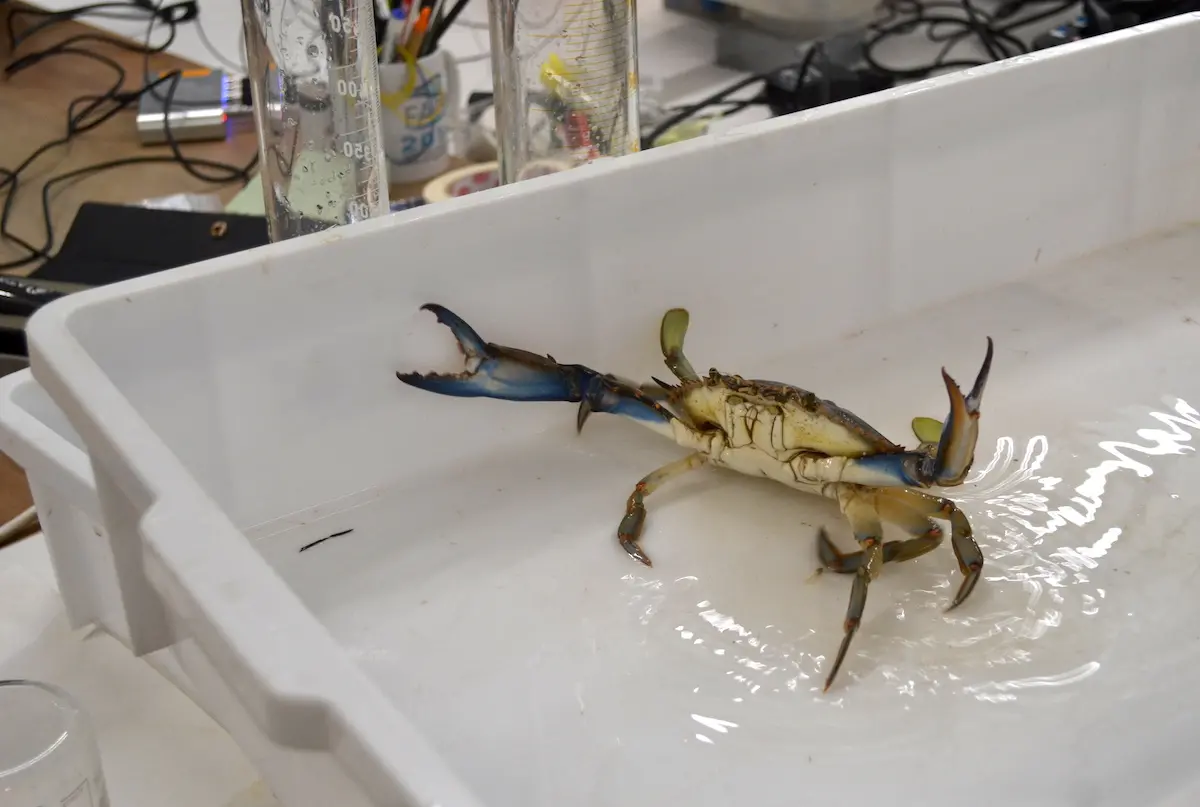
Citations:
Zenetos, A., Albano, P.G., López Garcia, E., Stern, N., Tsiamis, K., & Galanidi, M. (2022). Established non-Indigenous species increased by 40% in 11 years in the Mediterranean Sea. Mediterranean Marine Science, 23(1). doi:10.12681/mms.29106
Mancinelli, G., Bardelli, R., & Zenetos, A. (2021). A global occurrence database of the Atlantic blue crab Callinectes sapidus. Scientific Data, 8(1). doi:10.1038/s41597-021-00888-w
Mancinelli, G., Chainho, P., Cilenti, L., Falco, S., Kapiris, K., Katselis, G., & Ribeiro, F. (2017). On the Atlantic blue crab (Callinectes sapidus Rathbun 1896) in southern European coastal waters: Time to turn a threat into a resource? Fisheries Research, 194, 1-8. doi:10.1016/j.fishres.2017.05.002
Mancinelli, G., Chainho, P., Cilenti, L., Falco, S., Kapiris, K., Katselis, G., & Ribeiro, F. (2017). The Atlantic blue crab Callinectes sapidus in southern European coastal waters: Distribution, impact and prospective invasion management strategies. Marine Pollution Bulletin, 119(1), 5-11. doi:10.1016/j.marpolbul.2017.02.050
Shaiek, M., El Zrelli, R., Crocetta, F., Mansour, L., & Rabaoui, L. (2021). On the occurrence of three exotic decapods, Callinectes sapidus (Portunidae), Portunus segnis (Portunidae), and Trachysalambria palaestinensis (Penaeidae), in northern Tunisia, with updates on the distribution of the two invasive portunids in the Mediterranean Sea. BioInvasions Records, 10(1), 158-169. doi:10.3391/bir.2021.10.1.17
Mili, S., Ennouri, R., Zarrouk, H., & Fatnassi, M. (2021). Development of the fishing and commercialization of the blue crabs in Bizerta and Ghar EL Melh lagoons: A case study of promotion opportunities of blue growth in Tunisia. Journal of Aquaculture & Marine Biology, 10(2), 66-74. doi:10.15406/jamb.2021.10.00308
Kleitou, P., Crocetta, F., Giakoumi, S., Giovos, I., Hall-Spencer, J. M., Kalogirou, S., … Rees, S. (2021). Fishery reforms for the management of non-indigenous species. Journal of Environmental Management, 280, 111690. doi:10.1016/j.jenvman.2020.111690
Corsini-Foka, M., Abdulghan, A., Al Mabruk, S., Abdulrraziq, A., Ibrahim, S., Scannella, D., … Gianguzza, P. (2021). Invasive portunid crabs in Libyan waters: First record of the Atlantic blue crab Callinectes sapidus Rathbun, 1896 and range expansion of the swimming blue crab Portunus segnis (Forskål, 1775). BioInvasions Records, 10(4), 885-893. doi:10.3391/bir.2021.10.4.13
Deidun, A., & Sciberras, A. (2016). A further record of the blue swimmer crab Portunus segnis Forskal, 1775 (Decapoda: Brachyura: Portunidae) from the Maltese Islands (Central Mediterranean). BioInvasions Records, 5(1), 43-46. doi:10.3391/bir.2016.5.1.08












